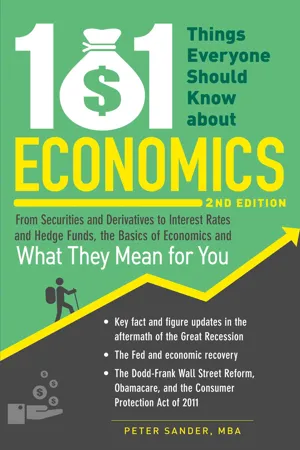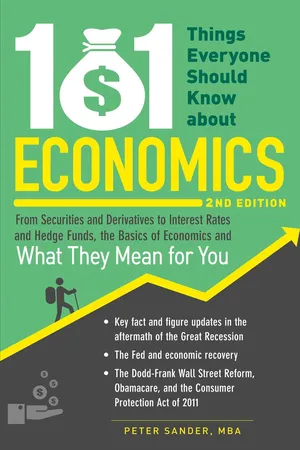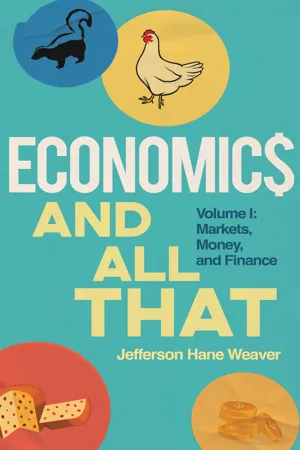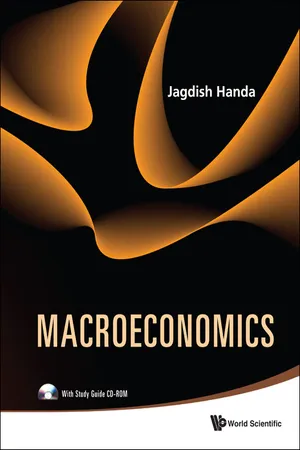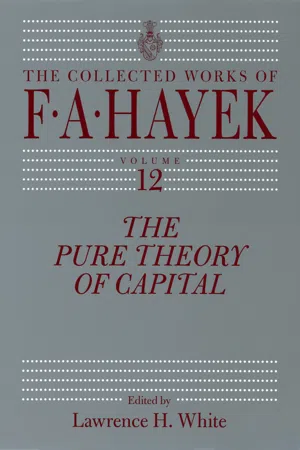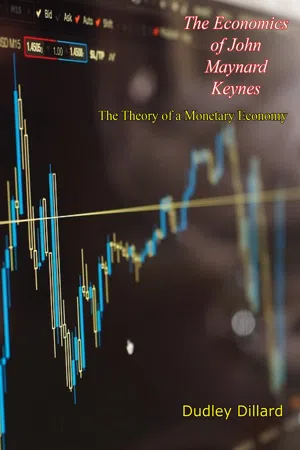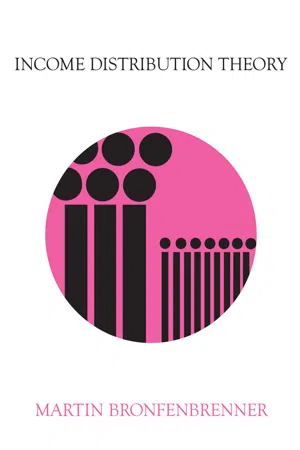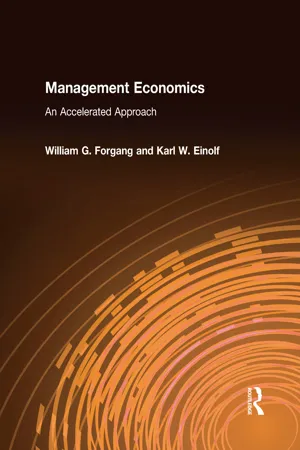Economics
Money and Interest Rates
Money and interest rates are key components of the economy. Money serves as a medium of exchange, unit of account, and store of value, while interest rates represent the cost of borrowing or the return on savings. Changes in the money supply and interest rates can have significant impacts on economic activity, investment, and inflation.
Written by Perlego with AI-assistance
Related key terms
12 Key excerpts on "Money and Interest Rates"
- eBook - ePub
- W. Charles Sawyer, Richard L. Sprinkle(Authors)
- 2020(Publication Date)
- Routledge(Publisher)
S o far, we have examined the institutional details of the foreign exchange market and explained what determines the exchange rate. The model of exchange rate determination developed in the previous chapter explains some of the movement in exchange rates. Both the rate of inflation and the growth rate of GDP usually do not change dramatically over short periods of time, such as one day to the next. Yet, exchange rates change almost every minute of every business day. As a result, we need to expand our model of exchange rate determination to include another factor that determines or influences exchange rate movements over short periods of time. This factor is short-term interest rates. Since interest rates have an important influence on the exchange rate, we need to describe what causes domestic interest rates to change. In the first part of the chapter, we will review and expand on what you learned in your Principles of Economics course concerning the supply and demand for money and the determination of the equilibrium interest rate within a domestic economy.In the second part of the chapter, we will examine the relationship between interest rates and the exchange rate. As we will see, any change in interest rates will lead to changes in the inflows and outflows of capital in a country’s financial account and the changes in capital flows lead to changes in the exchange rate. By the end of the chapter, we will be able to examine how changes in interest rates, the exchange rate, the current account, and the financial account all interact with one another.MONEY DEFINED: A REVIEWWhen trying to determine how money affects the exchange rate, our first objective is to define the term money. Most individuals believe that they know what money is, but in fact, what constitutes money is not clear at all. The easiest way to describe money is to consider what it does. Money has to perform three separate but important functions. First, it must act as a medium of exchange. This is money’s most important function. How would economic transactions be conducted in a world without money? Without money, every price would be a relative price. For example, the price of a hamburger would be defined as what a hamburger is worth in terms of all other goods and services. In an advanced economy with a large number of goods and services, this relative pricing quickly becomes untenable. The price of one hamburger might be defined as four soft drinks or .04 tires. No one could possibly keep track of all the possible relative prices. The power of money is largely dependent on solving this relative-price problem. If there are 50,000 goods in any economy, there are only 50,000 prices. This is complicated but the alternative is far more complicated. Even if governments did not produce money, some item would emerge as a medium of exchange. In anything other than the simplest economy, something would emerge to serve as money.1 - eBook - ePub
101 Things Everyone Should Know About Economics
A Down and Dirty Guide to Everything from Securities and Derivatives to Interest Rates and Hedge Funds - And What They Mean For You
- Peter Sander(Author)
- 2009(Publication Date)
- Adams Media(Publisher)
For the U.S. consumer, the sort of stagflation caused by oil shocks or similar shortages creates the most concern. If you see inflation in the economy, particularly energy and food prices, that should not be taken as signs of a robust economy; more likely, the economy will sink as higher prices sap the strength, like a tax, of the economy. If the government tries to deal with these effects by tightening the money supply, look out, especially if you’re in an economically sensitive vocation.The good news: the sort of stagflation caused by regulation or economic inefficiencies is less likely to happen in the United States than elsewhere. Despite what it may seem like sometimes, the U.S. economy is considered to have one of the easiest and most consistent regulatory climates of any developed country. This is why many economists are concerned when they hear cries for more regulation, and examine some of the policy changes and reversals that came with the recent economic crisis—they want to preserve the “stable state” the United States offers for capitalist commerce.21. INTEREST RATESAn interest rate is the price a borrower pays to borrow money. The key word is price—for whatever reason, possibly owing to the negative references to the borrowing and lending of money in the Bible—the concept that interest is a price paid for the use of something, in this case, money, is poorly understood by most. If you think of interest rates as a price, sometimes too high, sometimes a bargain, you’ll learn to make better decisions when evaluating a borrowing opportunity.From your point of view, interest rates are a price, or cost, of using money. They are also the price, or benefit received, for letting someone else use your money, as in when you deposit money in a bank or buy a bond. Finally, on a national scale, interest rates are also a vital tool used by governments to control money supply and the availability of credit, and thus to exert some control over the economy.What You Should KnowInterest rates are normally expressed as a percentage of a borrowed balance over the period of one year. Many interest rates are quoted as a nominal, or ongoing interest rate, with an “annualized percentage rate” quoted in parallel to account for all - eBook - ePub
101 Things Everyone Should Know About Economics
From Securities and Derivatives to Interest Rates and Hedge Funds, the Basics of Economics and What They Mean for You
- Peter Sander(Author)
- 2013(Publication Date)
- Adams Media(Publisher)
The good news: the sort of stagflation caused by regulation or economic inefficiencies is less likely to happen in the United States than elsewhere. Despite what it may seem like sometimes, the U.S. economy is considered to have one of the easiest and most consistent regulatory climates of any developed country. This is why many economists are concerned when they hear cries for more regulation, and why they became concerned with some of the proposed policy changes that came with the recent economic crisis—they want to preserve the “stable state” the United States offers for capitalist commerce.21. INTEREST RATES
An interest rate is the price a borrower pays to borrow money. The key word is price —for whatever reason, possibly owing to the negative references to the borrowing and lending of money in the Bible, the concept that interest is a price paid for the use of something, in this case, money, is poorly understood by most. If you think of interest rates as a price, sometimes too high, sometimes a bargain, you’ll learn to make better decisions when evaluating a borrowing opportunity.From your point of view, interest rates are a price, or cost, of using money. They are also the price, or benefit received, for letting someone else use your money, as in when you deposit money in a bank or buy a bond. Finally, on a national scale, interest rates are also a vital tool used by governments to control money supply and the availability of credit, and thus to exert some control over the economy.What You Should Know
Interest rates are normally expressed as a percentage of a borrowed balance over the period of one year. Many interest rates are quoted as a nominal, or ongoing, interest rate, with an “annualized percentage rate” quoted in parallel to account for all borrowing costs, including fees, associated with a borrowing transaction, on an annual basis. Federal law requires publication of APRs to allow simple “apples-to-apples” comparisons of the price to borrow money.The interest rate, or price, for the use of borrowed funds depends on several factors:- Length of loan term. How long will you keep the money you borrow? That will influence the price, because of two things. First is the opportunity foregone by the owner of the money to spend it or invest it in something else. People tend to prefer liquidity
- eBook - ePub
Economics and All That: Volume 1
Markets, Money, and Finance
- Jefferson Hane Weaver(Author)
- 2022(Publication Date)
- Armin Lear Press(Publisher)
How is the interest rate determined? As with much of economics, the answer is supply and demand. The interest rate reflects the supply of money created by the central banking authorities and the demand of both individuals and organizations (private and otherwise) for that money. If the central bank reduces the supply of money and the demand for that money is unchanged, then there is less money sloshing around in the economy and the interest rate will go up. Consumers will not be able to obtain the same number of dollars at the lower interest rate so the holders of those dollars will demand a higher interest rate for exchanging those dollars. Conversely, an increase in the supply of money when there is no real increase in demand will cause interest rates to fall because the holders of those dollars will have to accept less interest from borrowers if they exchange those dollars.We all engage in various types of economic transactions in order to build our financial empires. Some of us are more prone to take a walk through the Wall Street casino and invest our money in stocks, hoping that we will discover the next big thing and make gobs of money so that we can buy enormous houses and look down upon all of our former neighbors and co-workers. Others are more geared towards real property and will seek to own real estate such as apartments or shopping centers or warehouses, hoping that they can realize both income and asset appreciation and, as an added bonus, also look down upon all of their former neighbors and co-workers. Still others would prefer less risk and will place their money in government bonds and cash accounts, realizing that they may not enjoy the gains of their colleagues who have chosen stocks or real estate, but comfortable in the knowledge that an adverse turn in either the stock market or the real estate market will not destroy their value of their accounts. Even though they may only be able to afford an average sized house, these bond and cash investors will at least have a house when some of their more risk-oriented colleagues are having their mansions foreclosed on by their banks. - eBook - ePub
Macroeconomics
(With Study Guide CD-ROM)
- Jagdish Handa(Author)
- 2010(Publication Date)
- WSPC(Publisher)
CHAPTER 2 Money, Prices, Interest Rates, and Fiscal Deficits Some of the fundamental questions of macroeconomics concern the proper role of monetary, fiscal, and other policies in managing the economy. Money is the medium of payments. The money supply and interest rates have important effects on the economy. Changes in the central bank’s monetary policy on these variables are major determinants of aggregate demand in the economy and, therefore, of changes in the economy’s output, unemployment, price level, and the inflation rate. Governments usually run fiscal deficits or surpluses, which also impact on aggregate demand and interest rates, and then on output and unemployment. Among the most important questions in macroeconomic analysis are whether, how and to what extent changes in the money supply, interest rates, the price level, and inflation affect the economy’s real variables, especially national output and employment. The control of the money supply and interest rates rests with the central bank or ‘the monetary authority’. Its policies with respect to the money supply and interest rates are known as monetary policy. The government or ‘the fiscal authority’ determines the policies on government spending, taxes, and the fiscal deficit/surplus. Its policies with respect to these variables are known as fiscal policy. Both monetary and fiscal policies impact on a considerable number of macroeconomic variables. In particular, they affect aggregate expenditures and interest rates in the economy. 2.1 What Is Money and What Does It Do? 2.1.1 The functions of money Money is not itself the name of a particular asset and is best defined independently of the particular assets that may exist in the economy at any one time, since the assets which function as money tend to change over time in any given country and among countries. At a theoretical level, money is defined in terms of the functions that it performs - eBook - ePub
Islamic Money and Banking
Integrating Money in Capital Theory
- Iraj Toutounchian(Author)
- 2011(Publication Date)
- Wiley(Publisher)
Chapter 2 Interest on Money and Its Scope The most powerful force in the universe is compound interest. Albert Einstein Zero nominal rates of interest are necessary for efficient resource allocation. Friedman RuleMoney, interest, capital and profit are the four most important concepts in economics. They have become so entangled with each other that it seems almost impossible to disentangle them and to show the considerable distinctions between them. As a result, they have become the source of many misconceptions. While it is not the goal of this chapter or this book to fully disentangle these concepts, the problems arising from these misconceptions require some comment.I should make it clear from the outset that we are mainly concerned here with the nominal, as opposed to the real, rate of interest. Furthermore, interest is treated at a macro level irrespective of its importance at the micro level. The intention of this chapter is to deal with interest in so far as it comes into conflict with Islamic economic teachings. There are certain areas I have chosen to call “restricted zones” that belong exclusively to capitalism, from which we have to keep a distance. This does not mean, however, that they will go unchallenged.A Brief History of InterestInterest is arguably the most controversial concept in economics and it plays a pivotal role in capitalism. Sir Dennis Robertson's assessment that “nothing [is] ever allowed to happen … except through the rate of interest” has become something of a mantra, not only among Western economists but also among ordinary people in their everyday lives. In light of this, it behooves us to spend a little time to investigate the history and source of this misconception.In the early masterworks, philosophy, ethics, and justice were intertwined and became the source of economic thought. Over time, though, as undue emphasis was placed on specialization within the discipline of economics, they became separate academic issues. While this undoubtedly brought great material benefits to mankind, things of great value were lost in the process. The magnitude of such losses and how they came about are questions that need be answered. It is true that a negative attitude toward wealth existed among people of the past. As Ingrid Rima has pointed out: “The teachings of St. Augustine (354–439) and Thomas Aquinas (1225–74) were negative toward activities undertaken to pursue wealth and thus were difficult to reconcile with the need to accumulate” (Rima 1996: 27). It is also true that economics did not emerge as a separate field of inquiry until the satisfaction of material needs became a desirable goal of human activity. But it would be unfair to attribute materialistic advancement to economic science alone. Human invention and innovation have brought about material prosperity for people. - eBook - ePub
- F. A. Hayek, Lawrence H. White(Authors)
- 2011(Publication Date)
- University of Chicago Press(Publisher)
It is not a price paid for any particular thing, but a rate of differences between prices which pervades the whole price structure. Insofar as the money rate of interest is concerned, our rate of interest is merely one of the factors which helps to determine it, and is the phenomenon most nearly corresponding to it which we can find in our imaginary moneyless economy. But if it were not for the well-established usage, it would probably have been better to refer to this ‘real’ phenomenon either, as the English classical economists did, as the rate of profit, or by some such term as the German Urzins. 1 Limited Scope of Present Discussion of Money Rate of Interest Although a full discussion of the monetary problems to which the existence of the ‘real’ rate of interest gives rise lies outside the scope of the present book, it would hardly be appropriate to leave our subject without giving a somewhat more definite indication of how the rate of interest we have been discussing and the money rate of interest are related. At this point we can give no more than an outline of the answers to the main problems. A full discussion of the whole complex of problems involved would require another book of about the same size as this one—even supposing that, in the present state of our knowledge, any such systematic and exhaustive treatment of these as yet imperfectly explored problems could be attempted successfully. As has been explained earlier in this volume, its task is to lay the foundations for the treatment of these problems, not to discuss them in any detail. And we shall confine ourselves in this final Part to the task of showing how these theoretical foundations can be used for the elucidation of certain salient points in the discussion of these more complex problems - eBook - ePub
The Economics of John Maynard Keynes
The Theory of a Monetary Economy
- Dudley Dillard(Author)
- 2018(Publication Date)
- Papamoa Press(Publisher)
The rate of interest depends upon the state of liquidity preference taken in conjunction with the quantity of money. If liquidity preference remains unchanged, increases in the quantity of money will lower the rate of interest, and decreases in the quantity of money will raise the rate of interest. It is important to say something more about how changes in the quantity of money occur in modern economic societies.The total supply of money consists of bank deposits, paper money, and metallic coins. In highly developed capitalistic economies like the United States, the supply of money consists overwhelmingly of bank deposits, which represent liabilities of banks to pay money to depositors. No matter of principle is involved in determining whether savings deposits should be included under the category of money. If money is defined as the perfectly liquid asset, the presumption is against including savings deposits because banks have the right to require a certain number of days’ notice before they will convert a savings or time deposit into legal money. On the other hand, savings accounts differ from debts in that their value in terms of money is not subject to change. In some countries the statistical data do not permit a breakdown of total deposits between demand and time deposits. Even though a bank has the legal right to require, say, thirty days’ notice on savings accounts, this requirement is not always strictly followed. Keynes does, in general, include as money time deposits in banks. What matters most for the present discussion, however, is not what makes up the total quantity of money (M), but how changes in this total come about. These changes arise mainly from the lending and borrowing activities of the banking system. Therefore demand deposits, or what may be called check-book money, are the significant element of the money supply so far as the interest rate and Keynes’ theory of money are concerned. - eBook - ePub
- Jagdish Handa(Author)
- 2002(Publication Date)
- Routledge(Publisher)
But this decision having been made, there is a further decision which awaits him, namely, in what form he will hold the command over future consumption which he has reserved, whether out of his current income or from previous savings. Does he want to hold it in the form of immediate, liquid command (i.e., in money or its equivalent)? Or is he prepared to part with immediate command for a specified or indefinite period.…It should be obvious that the rate of interest cannot be a return to saving or waiting as such. For if a man hoards his savings in cash, he earns no interest, though he saves just as much as before. On the contrary,…, the rate of interest is the reward for parting with liquidity for a specified period.…Thus the rate of interest at any time, being the reward for parting with liquidity, is a measure of the unwillingness of those who possess money to part with their liquid control over it. The rate of interest is not the ‘price’ which brings into equilibrium the demand for resources to invest with the readiness to abstain from present consumption. It is the ‘price’ which equilibrates the desire to hold wealth in the form of cash with the available quantity of cash.… If this explanation is correct, the quantity of money is the other factor, which, in conjunction with liquidity preference, determines the actual rate of interest in given circumstances. Liquidity-preference is a potentiality or functional tendency, which fixes the quantity of money which the public will hold when the rate of interest is given; so that if r is the rate of interest, M the quantity of money and L the function of liquidity preference, we have M = L (r ). This is where, and how, the quantity of money enters into the economic scheme.(Keynes, 1936, pp. 166–68)First, consider Keynes’ argument in terms of its general notion that the rate of interest is the reward for parting with liquidity. This is definitely true in a world with uncertainty. Savers have a choice as to the form in which to hold their savings. They may hold these in a monetary form or lend it. If the level of the rate of interest determines their division of savings into money balances versus loans, the rate of interest can be called the reward for parting with liquidity in the process of lending. However, if the rate of interest also influences the level of savings, then it may also be called a reward for postponing consumption. Both cases apply in the real world.9 - eBook - ePub
- Martin Bronfenbrenner(Author)
- 2017(Publication Date)
- Routledge(Publisher)
CHAPTER THIRTEENMonetary Interest Theory
Introduction
1. We have thus far treated differences between inputs and outputs, or between capital and consumption goods, as matters of black and white. We know gray areas exist, but are seldom important.1 But we can no longer do this in capital theory. In dealing with problems of capital and interest, it is dangerous to neglect the omnipresence of a special sort of investment good. On the one hand, this good is competitive with other investment goods (and titles to them) on capital markets. One may speak of its productivity, like that of any other intermediate good. On the other hand, the good in question is also valued like consumption goods, for its direct services relate only tortuously, if at all, to considerations of productivity or efficiency.2. This universal-equivalent investment good is, of course, money, held in the form of cash balances (including bank deposits). Interest is paid explicitly for its direct services when it is lent. For its sake, also, machines or inventories are forgone so that cash positions can be maintained or improved. In these cases, one may think of money as earning implicit interest. By “money” we shall mean real money, deflated for price changes, rather than nominal money.The direct service of money is called liquidity . Its formal analogy is with physicians’ or attorneys’ direct services in wage theory, in that productivity considerations are vague, forced, and strained. Its importance is greater, possibly by an order of magnitude. The demands for both money as such and for its service of liquidity have been combined, since Keynes’ General Theory , in the rubric of liquidity preference.Any commodity x is economically liquid, if, with a high probability (approaching unity), its holders can rationally expect to reduce or close out their holdings of x whenever they so desire after an infinitesimal time interval, without risk of loss of real income or wealth. Money includes any x with these properties, whose real value would decline substantially if the liquidity attribute should disappear or be attenuated.2 - eBook - ePub
- Rousseas(Author)
- 2016(Publication Date)
- Routledge(Publisher)
More generally, what all this adds up to is that the notion of a market-clearing equilibrium "interest" rate—whether in the old "productivity-thrift" theory, or the "bastard" Keynesian IS-LM approach, or a market-determined short-run rate—is a theoretical fiction used to provide determinate theoretical solutions within arcane models bearing no relation to the real world. In the universe of economics, interest rates are not the equilibriating force of textbooks. They are essentially a markup over competitive prime costs in a broadly conceived financial sector that is bound to exhibit an even greater concentration of economic power, especially in the banking industry, as the recent, hasty deregulation of the financial sector leads to an even higher level of bank failures, the forced merger of those that do survive with the giants of the banking industry, and the entry into the banking industry of nontraditional types of institutions. In the meantime, the impact of structurally higher and uncapped interest rates all along the liquidity spectrum on what Keynes called the sector of "Industrial Circulation" will be pronounced since interest rates in their varied manifestations will play an even more significant role than before in determining investment, profits, and the process of capital accumulation and growth in a capitalist society.Notes
1. A Treatise on Money (London: Macmillan, 1930), Vol. 1, p. 243, original italics. Subsequent quotations are from Volume 1, Chapters 3 and 15.2. "The General Theory of Employment," Quarterly Journal of Economics, February 1937, "Alternative Theories of the Rate of Interest," Economic Journal, June 1937, and "The 'Ex Ante' Theory of the Rate of Interest," Economic Journal, December 1937.3. Although the basic equations are taken from Davidson's Money and the Real World, Chapter 7, they have been significantly altered and the model as a whole is sharply and substantively different from that of Davidson.4. See especially, J. A. Kregel, "Constraints on the Expansion of Output and Employment: Real or Monetary?" Journal of Post Keynesian Economics , Winter 1984-85.5. See Hyman P. Minsky, John Maynard Keynes (New York: Columbia University Press, 1975), Chs. 2 and 3.6. Michal Kalecki, Selected Essays on the Dynamics of the Capitalist Economy, 1939–1970 (New York: Cambridge University Press, 1971), Ch. 5.7. Paul Meek, U.S. Monetary Policy and Financial Markets - eBook - ePub
Management Economics: An Accelerated Approach
An Accelerated Approach
- William G. Forgang, Karl W. Einolf(Authors)
- 2015(Publication Date)
- Routledge(Publisher)
the appendix to Chapter 4 .Interest RatesInterest rates are the price of credit, and changes in interest rates have a substantial effect on the macroeconomy. Interest rates affect businesses’ and households’ willingness to make purchases on credit. For example, consider an individual planning to purchase a new $25,000 vehicle. For purposes of the example, the full amount of the purchase price is financed over five years. For simplicity, one payment is made at the end of each year. At 5 percent interest on the loan, the annual cost of the vehicle is $5,774; at 8 percent, the annual cost is $6,261. Higher interest rates raise the cost of purchases and reduce aggregate demand.A second example of the effect of interest rate changes refers to business investment spending. Consider a firm examining the purchase of a machine that increases output by 100 units per year (see Table 3.13 ). It is expected that each additional unit of output is sold at $2. The life expectancy of the new machine is five years, and it has no salvage value or disposal cost. The purchase price of the machine is $200. The example is simplified by ignoring the tax consequences of the loan and the annual depreciation of the machine. At 5 percent, the present value of the increased profits from the increased sales ($216.46) exceeds the cost of the new machine ($200). The machine should be purchased. At 10 percent, the present value of the increased profits ($189.52) is less than the price of the machine ($200). The machine should not be purchased.Applicationn Box 3.14Loan amortization payments are determined through the use of present value calculations. Assume a $25,000 loan for five years at 8 percent. The present value of the series of payments must equal the loan amount. To solve for the payment:
Index pages curate the most relevant extracts from our library of academic textbooks. They’ve been created using an in-house natural language model (NLM), each adding context and meaning to key research topics.

